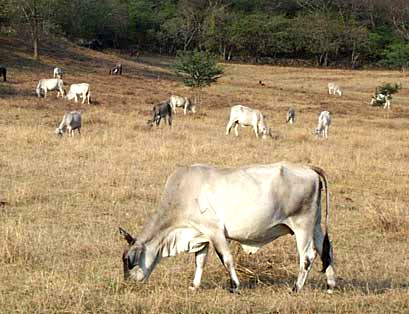Excerpts from Jim Conrad's
Naturalist Newsletter
from the May 19, 2007 Newsletter, issued from Sierra Gorda Biosphere Reserve Headquarters in Jalpan, Querétaro, MÉXICO
CHARBRAY CATTLE

The most conspicuous breed of cow seen around here is the big, white one shown above. At first I thought it was a Zebu, famous for thriving in tropical heat. The loose flap of skin hanging below the neck is typical of Zebus, and helps radiate heat, thus cool the cow. However, the cow in our picture lacks the large hump on the back, above the forelegs, which adult Zebus have.
So I had to do an image search on the Internet, using the key words "razas de vacas en Querétaro," or "cattle breeds in Querétaro." Many images of many breeds came up, but our cow looks most like what's called the Charbray.
The ContextoGanadero.Com website says that Charbrays are crosses between the Charolaise and Brahman breeds -- 5/8 Charolaise and 3/8 Brahman. That website considers the Charbray to have the right mix of the Charolaise's meat-producing potential, and the Brahman's tolerance of heat and other features of tropical and semitropical savannas and pastures.
Taxonomically, Querétaro's Charbrays often are known as Bos taurus subspecies taurus x Bos taurus subspecies inducus, the "x" between the names indicating hybridization between two recognized taxa. Therefore, both the Charolaise and Brahman breeds belong to the species Bos taurus. However, I've seen Charbrays referred to as Bos taurus and Brahmans called Bos indicus. The Charolaise was developed in France, while the Brahman originally is from India. Zebu cattle, very similar to Charbrays but bearing large humps on their backs, are considered to belong to the same subspecies as Brahmans, but they're different "breeds" or races.
There's a page in English about the Charbray at the Charbray.Org Website.